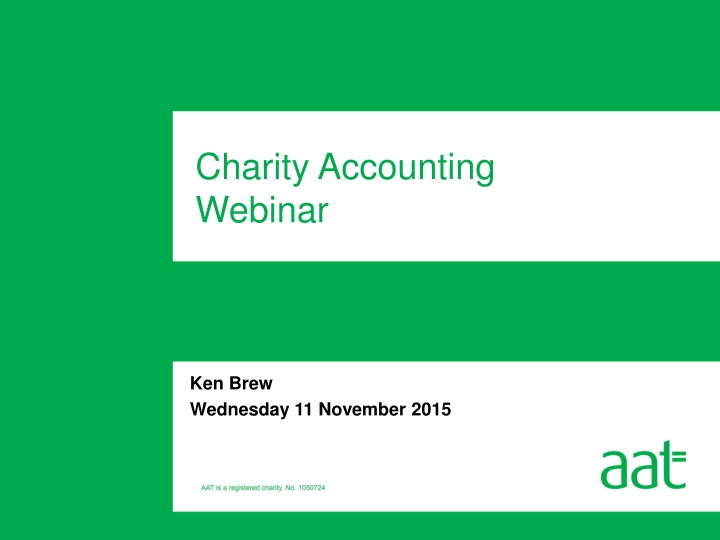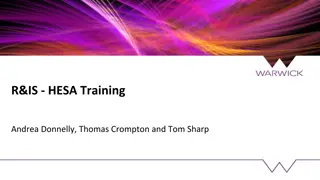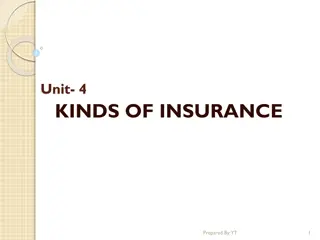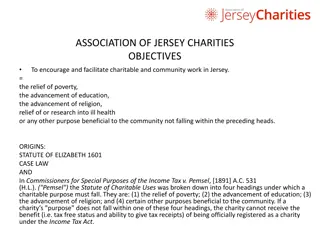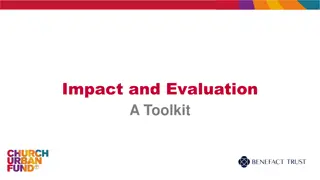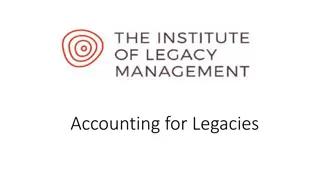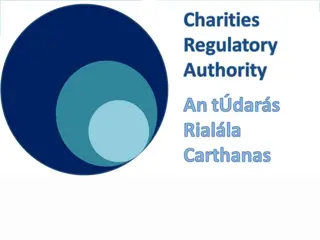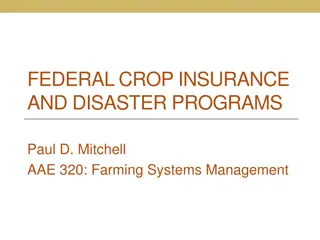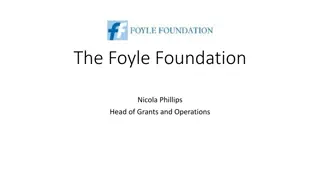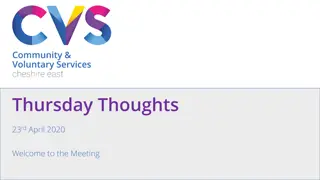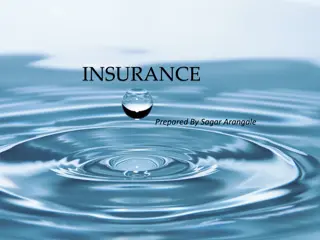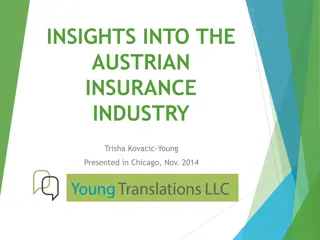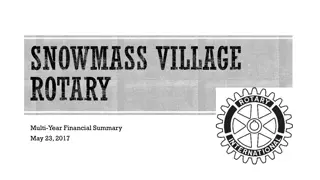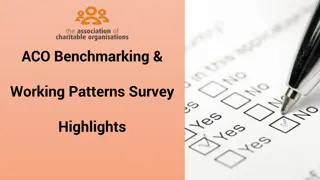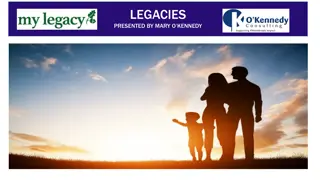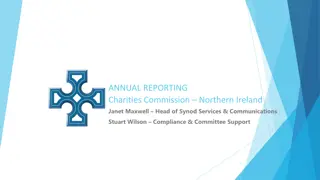The Insurance Charities - Providing Help and Support to Insurance Employees
Established in 1902 in response to high mortality rates, The Insurance Charities offer financial aid to past and present insurance employees and their dependants. With a focus on supporting individuals across the UK and Ireland, their holistic approach helps families overcome challenges and regain self-sufficiency. Through donations and initiatives like the Leicester Insurance Institute, they aim to make a positive impact on those in need within the insurance industry.
Download Presentation

Please find below an Image/Link to download the presentation.
The content on the website is provided AS IS for your information and personal use only. It may not be sold, licensed, or shared on other websites without obtaining consent from the author.If you encounter any issues during the download, it is possible that the publisher has removed the file from their server.
You are allowed to download the files provided on this website for personal or commercial use, subject to the condition that they are used lawfully. All files are the property of their respective owners.
The content on the website is provided AS IS for your information and personal use only. It may not be sold, licensed, or shared on other websites without obtaining consent from the author.
E N D
Presentation Transcript
Charity Accounting Webinar Ken Brew Wednesday 11 November 2015
Charity SoRPs AAT is a registered charity. No. 1050724
Why has charity accounting changed? UK Generally accepted accounting Practice (GAAP) has changed from 1/1/2015 (1/1/14?) New GAAP required a new SORP SORP consultation in 2013 with 26 events, 1600 participants and 179 responses Two new SORPs to take effect for financial years beginning on or after 1 January 2015
Two regimes underpin the framework Company Law for companies (strong link to FRS 102 via True and Fair requirement) Non-companies governed by Parliamentary Regulations which will implement the charities SoRP Harmonised by True and Fair over-ride
Why two SORPs? A separate FRS 102 SORP and a separate FRSSE SORP Trustees need to make the choice Why two SORPs? Because: EU accounting Directive (mandatory from 2016) changes small company reporting and FRSSE A new FRSSE framework needed in 2015-16 FRED59 published February 2015 small companies and other amendments Two SORPs avoids disruption to FRS 102 users Two SORPs simplifies the text of each and potentially addresses the needs of smaller charities Overtaken by events!?
Potential Charity Accounting framework Receipts and payments Available to non-company charities with an annual income of 250k or less Not available to charities or companies within a charity group Micro entities Option for small charities To be withdrawn for accounting periods starting on or after 1 January 2016 FRSSE New Section 1A to FRS 102 New small entities section to FRS102 Subject to 2015 SoRP consultation Full FRS 102 Option for all charities
The Financial Reporting Standard for Smaller Entities (FRSSE) A revised FRSSE issued by FRC issued in 2013 and applied to reporting periods beginning on or after 1 January 2015 ( early adoption is permitted ) A new FRSSE SORP was issued in 2014 and applies to reporting periods beginning on or after 1 January 2015 But both the FRSSE and FRSSE SORP are to be withdrawn for reporting periods beginning on or after 1 January 2016 (before the new regime is into its stride)
Why is the FRSSE being withdrawn? EU Accounting Directive introduced into company law and is applicable for accounting periods commencing on or after 1 January 2016 Accounting standards needed to reflect these changes in company law In July 2015 a new section 1A was added to the Financial Reporting Standard which replaces the FRSSE for accounting periods commencing on or after 1 January 2016
The difficult choice facing small charities in 2015 Adopt the FRSSE knowing it will be withdrawn within 12 months! More change will be needed Go the whole way with FRS 102 Return to Receipts and Payments accounts (not available for companies). Adjusting back to accruals in future may be problematic
Charity Accounting Framework 2016? Available to non-company charities with an annual income of 250k or less Receipts and payments New Section 1A to FRS 102 New small entities section to FRS102 Subject to 2015 SoRP consultation Full FRS 102 Option for all charities?
Charities in England and Wales November 2015 Income band Number of charities Total income 000 Long term assets 000 0 to 10k 76,620 235,664 891,970 10k to 100k 56,155 2,060,023 7,548,376 100k to 500k 21,495 4,774,482 17,607,681 500k to 5m 8,545 13,060,116 35,964,806 Over 5m 2,074 49,357,030 129,521,706 Total 164,889 69,487,315 191,534,539
Charity SoRPs - recent developments AAT is a registered charity. No. 1050724
Changes in the Charity Framework since March 2015 Definitions of large and small charity are changing New S1A of FRS102 to underpin the FRSSE? SORP consultation in summer 2015 on what will replace the FRSSE SoRP and the new thresholds for cash flow statements Charity Commission guidance on the application of the new SoRPs
Small has two meanings Small companies Small charities
Small entity thresholds for companies Current Gross Income (turnover) not more than 6.5m From 1 January 2016 Gross Income (turnover) not more than 10.2m Balance Sheet (Statement of Financial Position) not more than 3.26m Balance Sheet not more than 5.1m Not more than 50 employees Not more than 50 employees
What does SORP mean by a larger charity? For FY ending after 31 March 2015 definition could be based on the charity audit requirements of: Gross income exceeds 1,000,000 (still 500,000 in Scotland) or Gross income exceeds 250,000 and total assets exceed 3.26m Charities subject to audit are larger charities and more is required of them by the charities SORP Charities not subject to audit are smaller charities which have had some concessions under the SORP
Section 1 A to FRS 102 True and Fair view required Provides formats for primary statements No requirement to prepare a statement of cash flows Sets out mandatory disclosures based on company law Applies recognition & measurement bases of FRS 102 Additional disclosures may be required to meet true & fair requirement (need to consider disclosure requirements of section 8 to 35 of FRS 102 when transaction/event is material)
What should replace the FRSSE SoRP? A guide to applying S1A of FRS102 A new charities SoRP (FRS102 small entities) based on FRS102 with S1A disclosures Applying S102 in full but with a new threshold applying for the preparation of cash flows SoRP Committee considered three options
SoRP Committee preference The preferred option of the SORP-making body and the Charities SORP Committee is to dis-apply Section 1A and require all charities, irrespective of size, to apply FRS 102 and FRS 102 SORP in full The Committee felt there would be very few practical differences between the two SORPs other than some minor disclosure requirements
Charities SoRP consultation closed September 2015 Question 1 Given the underlying requirement for the accounts to give a true and fair view and the requirements of FRS 102 that result in all charities applying the same underlying recognition and measurement policies, do you agree with the SORP-making body dis-applying the small entities regime proposed in FRED 59? This would have the result that all charities will have to apply the Charities SORP (FRS 102) for reporting periods beginning on or after 1 January 2016?
Charities SoRP consultation to be published late November 2015 Question 2 Do you agree with the proposal to amend the Charities SORP (FRS 102) so that it requires only larger charities to prepare a Statement of Cash Flows? This would mean that all charities with a gross income exceeding 500,000 ( 500,000 in the Republic of Ireland) would have to prepare a Statement of Cash Flows.
Advantages of extending scope of FRS102 Same recognition & measurement bases apply to all The accounting treatment of an item depends upon its character and not the size of the reporting charity Expectation that charities will need to consider and provide any additional disclosures of FRS 102 where items are material in order to meet true and fair requirement
SoRP Committee concluded. Therefore, the disclosure needs are the same whether the charity meets the criteria of a small entity or not BUT This may be true in practice for accountants but compulsory adoption of FRS102 SoRP is likely to worsen the already significant disconnection between trustees and their year-end accounts in smaller charities. ( for accountants ) A complete U turn since 2013!!
Charity Commission Guidance Charity reporting and accounting: the essentials (CC15C) issued re the increase in audit threshold On early adoption the requirement to prepare accounts that are true and fair takes precedence and therefore it is possible to apply either of the new SORPs in preference to the SORP specified in the 2008 Regulations provided this is clearly advised in the notes to the accounts.
We are still waiting for .. The results of the 2015 consultation (later this month) Adopt full FRS102 only? Introduce an opt out for smaller charities re cash flow statements? Will this introduce a new 500k income threshold for large charities per SoRP as opposed to audit? Regulations laid before Parliament re the new SoRP (must be soon) The first sets of FRS102 charity accounts to be published (Spring 2016?)
New Charity SoRPs Some headline changes AAT is a registered charity. No. 1050724
The Fund Framework All Funds Unrestricted Funds Restricted Funds Non- Designated Funds Restricted Income Funds Endowment Funds Designated Funds Income Capital Income Unrestricted Permanent Endowment Restricted Funds: Can ONLY (normally) be restricted by DONOR CAN be created by making appeal - so take care with appeal surpluses or deficits Income Restricted Expendable Endowment
Structure of new Charities SORP Consultation draft of SORP addressed both FRS 102 and FRSSE Modular approach Core modules Specialist modules
SoRP Consultation - Modules Modular approach - Pick and mix online of 29 Modules Fourteen - Core Three - Special transactions (including grant making) Two - Types of assets (Heritage and Acting as Custodian) Three - Investments (Total Return, Pooling, Social investment) Seven - Group Accounts
Charities SoRP 14 Core Modules Statements Underlying concepts Accounting Treatments for Charities 1. 3. Accounting Standards, policies, concepts and principles 5. Recognition of Income 8. Allocating costs by activity within SoFA Trustees Annual Report 6. Donated goods and services 4. SoFA 7. Recognition of expenditure 9. Disclosure of trustee and staff remuneration 10. Balance Sheet 11. Accounting for financial assets and liabilities 13. Events since the year end 14. Statement of Cash Flows 12. Impairment of assets 2. Fund Accounting
Charities SoRP -15 Special Modules Charity Operations Types of Asset and investments 18. Heritage assets Branches, groups and Combinations 23. Combinations overview 15. Charities and company law 16. Presentation of grant making 19. Custodian trustee 24. Accounting for groups 25. Branches and joint arrangements 17. Retirement and post- employment benefits 20. Total return on investments 21. Social investments 22. Pooling investment funds 26. Subsidiaries 27. Mergers 28. Associates 29. Joint ventures
SoRP Consistent terminology Compliance necessary in order to show a true and fair view Non-adherence is a departure from the SoRP MUST SHOULD Good practice Not a departure from the SoRP Optional Indicates that there are alternative approaches available MAY
Changes to the Trustees Annual Report (all charities) Common format whether FRSSE or FRS 102 or cash accounting Distinguishes requirements of all charities from those of larger charities (those subject to statutory audit) as a separate section Main changes to content requirements for all charities are: All trustees must be listed Must disclose if no reserves policy with reasons
Changes to the Trustees Annual Report (larger charities) Main changes to content requirements for larger charities are explanations of: Social investment policies Financial effect of significant events Principal risks and uncertainties and a summary of plans and strategies for managing them Reserves definition (use SORP or explain your own) Arrangements for setting pay of key management personnel and any benchmarks, criteria or parameters used
Module 1 TAR Reserves Paragraphs 1:22 and 1:48 Explain any policy for holding reserves State the amount of reserves and why they are held If decided not to hold reserves, disclose fact and explain MUST State total funds at the end of the period Identify restricted or fixed assets or programme related investments Identify and explain designated funds and timing of spend Calculate the amount of reserves at the end of the period Compare this with the reserves policy and provide explanations of how it will be brought into line in future SHOULD
Trustees Annual Report Reserves are charity s freely available income funds Permanent endowment funds Definition normally excludes Expendable endowment funds Restricted funds Funds only available by disposing of: Fixed assets for charity use Programme related investments And unrestricted funds not readily available for spending Expendable endowments But charities may have more or less reserves available e.g. Unrestricted funds earmarked or designated for essential spending T8
New Charities SoRPs SoFA changes Statement of financial activities (SOFA) The income and expenditure headings in the SOFA have been changed and simplified New heading cost of raising funds and governance costs are not shown separately on the face of the SOFA but are treated as a component of support costs. Investment gains and losses now counted as a component of net incoming resources / resources expended.
Structure of the SoFA Unrestricted Endowment Prior period Total funds Restricted total funds funds funds funds Income and endowments from: Donations and legacies I from Charitable activities Other trading activities I from Investments Other Total Income and Endowments Expenditure on: Raising funds Charitable activities Other Total Expenditure Net gains/(losses) on investments Net income (expenditure)
2005 SORP (SoFA extract) Voluntary income Activities for generating funds Investment income Incoming resources from charitable activities Other incoming resources Total incoming resources FRSSE SORP (SoFA extract) FRS 102 SORP (SoFA extract) Donations and legacies Other trading activities Donations and legacies Other trading activities Income from Investments Income from Charitable activities Other income Income from Investments Income from Charitable activities Other income Total income and endowments Expenditure on Raising funds Total income and endowments Expenditure on Raising funds Costs of generating voluntary income Fundraising trading: cost of goods sold and other costs Investment management costs Resources expended on Charitable activities Governance costs Other resources expended Expenditure on Charitable activities Other expenditure Expenditure on Charitable activities Other expenditure Net gains/(losses) on investments Net income/ (expenditure) Net incoming/outgoing resources before transfers Gross transfers between funds Gains on revaluation of fixed assets for charity s own use Gains/losses on investment assets Actuarial gains/losses on defined benefit pension schemes Net movement in funds Net income/(expenditure) Transfers between funds Transfers between funds Gains/(losses) on revaluation of fixed assets Gains/(losses) on revaluation of fixed assets Gains/(losses) on investment assets Actuarial gains/(losses) on defined benefit pension schemes Net movement in funds Actuarial gains/(losses) on defined benefit pension schemes Other gains/(losses) Net movement in funds
Income Recognition Income is recognised in the Statement of Financial Activities (SoFA) when a transaction or other event results in an increase in the charity s assets or a reduction in its liabilities.
Income Recognition Income must only be recognised in the accounts of a charity when all of the following criteria are met: Entitlement control over the rights or other access to the economic benefit has passed to the charity. Probable it is more likely than not that the economic benefits will flow to the charity. Measurement the monetary value or amount of the income or costs can be measured reliably.
Income Recognition Legacies Know of the existence of a valid Will AND Know about the death of the benefactor Entitlement Must show entitlement plus Probability of receipt plus Ability to estimate with sufficient accuracy the amount receivable To recognise income There has been Grant of Probate and Executors have established that there are sufficient assets in the Estate and Any conditions attached are within the control of the charity or have been met Receipt probable when
Income Recognition : Legacies (cont). Payment is received or notified after the reporting date and before accounts are authorised but payment was agreed by the executors prior to the end of the reporting period, then treat as adjusting event and accrue it as income. Always use fair value If charity has entitlement but the amount is uncertain then disclose as a contingent asset Large charities may use a portfolio approach If to be received > 12 months from the reporting date then discounting can be used but unwind against legacy income. If there is impairment then make the adjustment between income (not expenditure) and debtors.
Some differences between FRS102 and FRSSE FRS102 does not permit changes to Investment Property values to be taken to reserves. FRS102 has no 90% benchmark on finance leases FRS102 does not require names of Related parties but does require specific aggregate information FRS102 has a mandatory accrual on employee benefits FRS102 has a widespread use of Fair value could be onerous on financial instruments FRS102 assumes a maximum 5 year life on intangible assets FRS102 has mandatory cash flow statements FRS102 covers more areas ..
New Charity SoRPs Practical Outworking AAT is a registered charity. No. 1050724
No early adoption of FRS 102 for charities For non companies charity regulations require adoption of methods and principles of SORP 2005 Therefore cannot apply FRS 102 until regulations amended Therefore SORP Committee advise against early adoption Some requirements of SORP 2005 conflict with FRS 102
Possible adjustments on transition to FRS102 Restating certain assets and liabilities at a different value Recognising assets/liabilities not previously recognised Recognising adjustments on transition in retained profits Not recognising assets/liabilities previously recognised Reclassifying items
Charities SoRP Items most likely to be onerous for smaller charities . Income (almost) virtually certain Paid Annual Leave accrual FRS102 treatment of defined benefit pension scheme Goods for resale Concessionary Loans at Fair Value Other financial instruments Extended credit on contracts Cash flow data if required ..require adjustment if FRS 102 adopted?!
Common items to consider when adopting FRS102 Restating assets Fair value Derivatives Holiday pay Pension Funds Government Grants (new SoRP) Staff Costs Trustee benefits Reconciliations of Funds and Income
SORP micro-site Dedicated site: www.charitysorp.org Micro-site is the location for: Free SORPs and modules Customise your SORP Three help-sheets Order hard copy SORPs Future SORP Committee arrangements Two FRS 102 model examples added Background to the changes Mapping of the previous SoRP
